Download Class 7 Science Cell Notes in PDF format. All Revision notes for Class 7 Science have been designed as per the latest syllabus and updated chapters given in your textbook for Science in Class 7. Our teachers have designed these concept notes for the benefit of Class 7 students. You should use these chapter wise notes for revision on daily basis. These study notes can also be used for learning each chapter and its important and difficult topics or revision just before your exams to help you get better scores in upcoming examinations, You can also use Printable notes for Class 7 Science for faster revision of difficult topics and get higher rank. After reading these notes also refer to MCQ questions for Class 7 Science given on studiestoday
Revision Notes for Class 7 Science Cell
Class 7 Science students should refer to the following concepts and notes for Cell in Class 7. These exam notes for Class 7 Science will be very useful for upcoming class tests and examinations and help you to score good marks
Cell Notes Class 7 Science
Introduction of Cell
Cytology: The cell and its structures are studied under a branch of biology called cytology. Father of cytology – C.P. Swanson
Cell:- The structural & functional unit of a living being is called cell. An unit of biological activity, delimited by a differentially permeable membrane and capable of self reproduction in a medium free of other living system.
Cell is called structural & functional unit of life because –
(i) All the living organisms are composed of one or more cells.
(ii) All the cells have similar basic structure.
(iii) Similar cell organelles of different cell perform similar functions.
Discovery of cell
1. Robert Hooke (1665):- He observed a thin section of bark of a tree under self designed microscope. He coined the term cell. He wrote a book- Micrographia.
2. Anton Van Leeuwenhoek (1674) was first to observe living cells.
3. N. Grew (1682): Proposed cell concept which states that cell is unit of structure of organisms.
4. Knoll & Ruska (1932): Designed the electron microscope which was employed to study the ultra structure of cell and various cell organelles.
Cell theory :
Proposed by M.J. Schleiden & Theodore Schwann {two german biologists}.It was later expanded by Rudolf Virchow
(i) All plants and animals are composed of cells.
(ii) Cell is the functional unit of life.
(iii) All cells arise from pre- existing cell. (Rudolf Virchowomnis cellula -e- cellulate)
(A) Size of cell – Normal size in human 20 μ m to 30 μ m in diameter.
(i) Largest cell – In animal – Ostrich egg (15 cm in diameter) In plants – Acetabularia (6-10 cm)
(ii) Longest cell – In animal – Nerve cell (up to 1mt) In plants – Hemp fibre.
(iii) Smallest cell – PPLμ – Pleuro pneumonia like organism
(Mycoplasma – 0.1 μ m to 0.5 μ m)
(B) Shape of cell – Shape of cell mainly depends upon the specific function it performs.
(i) Elongated – Nerve cell
(ii) Discoidal/ saucer- RBC
(iii) Spindal – Muscle cell
(iv) Spherical – Eggs.
(v) Branched – Pigment cell of the skin
(vi) Slipper shaped – Paramecium
(vii) Cuboidal – Germ cell of gonads
(viii) Polygonal – Liver cells.
(C) Number of cells – On the basis of number of cells the organisms can be categorised as –
(i) Unicellular – Single celled – eg- Amoeba, Paramecium, Euglena, Plasmodium – Malarial parasite, Chlamydomonas.
(ii) Multicellular – Numerous cells eg- higher plants & Animals.
Differences between Prokaryotic & Eukaryotic Cells:
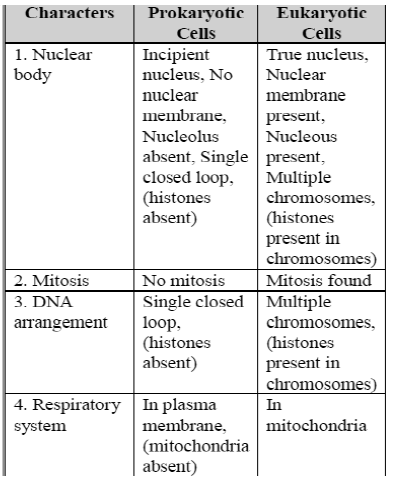
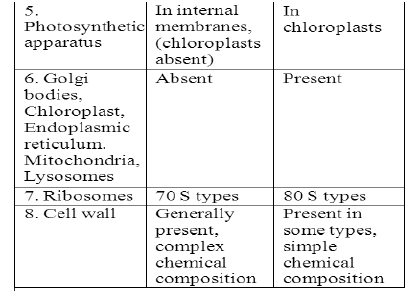
Difference between plant cell & animal
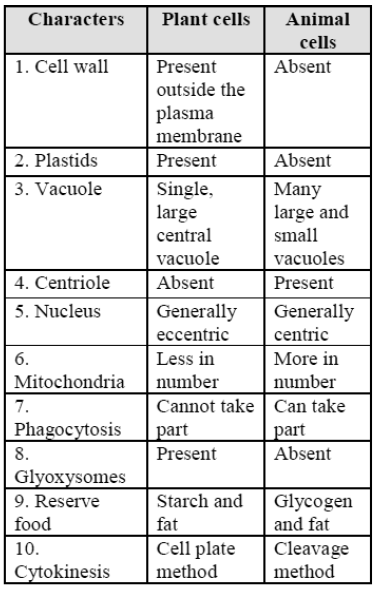
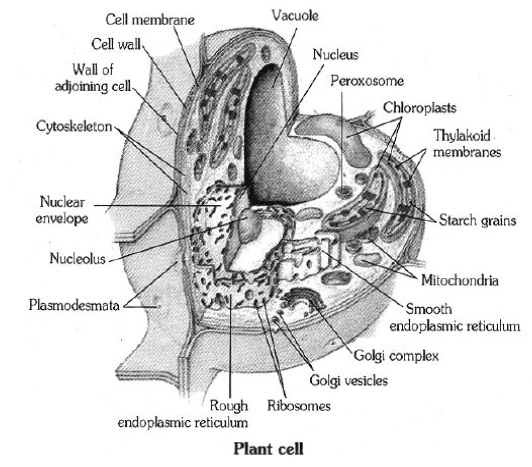
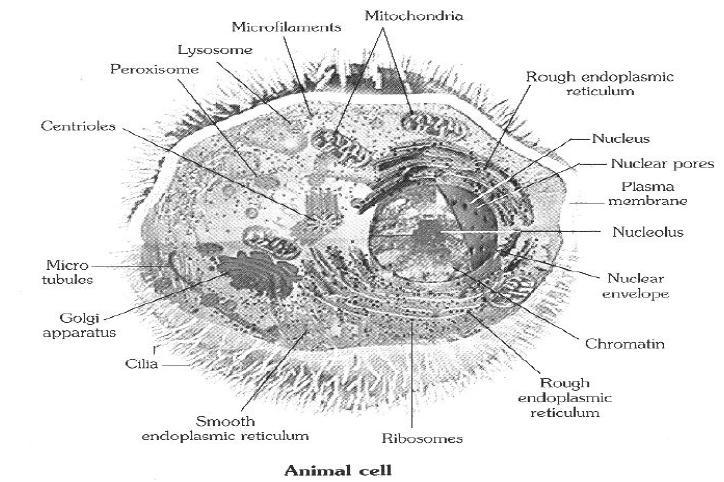
Cell Structure :-
Cell membrane or plasma membrane or plasmalemma :
The outermost living cover or envelope of every cell is called membrane. The limiting boundary of each cell which separates the cytoplasm from its surroundings is called cell membrane.Term plasma membrane was given by Nageli.
The most accepted structural model of plasma membrane is Fluid mosaic model. It was proposed by S.J. Singer & Nicolson. It states that plasma membrane is a lipoproteinous and trilaminar membrane in which outer and i n n e r layers are formed of globular protein molecules.
Function:-
1. Plasma membrane is also called selectively permeable membrane because it allows the entry and exit of selected materials in and out of the cell while it also prevents the movement of some other materials.
2. Plasma membrane bounds the semi-fluid content of the cells.
3. Plasma membrane protects the cell from injury and provides an outer boundary to the cell.
4. The membrane allows the flow of materials and information between different organelles within the cell as well as between one cell and another.
5. The membrane has carrier proteins for active transport.
CELL WALL :
Discovered by Robert Hooke
The outermost covering of the plant cell is called cell wall.It is absent in animal cell.It is rigid,thick, porous and non- living structure.Middle lamella is consist of Ca & Mg pectates (Plant cement). Amount of Calcium is more.
Function:-
(i) It provides a definite shape to cell.
(ii) It is a protective and supportive coat.
(iii) It is permeable and allows entry of molecule of different size.
(iv) It counteracts the osmotic pressure.
(v) It provides rigidity to the cell.
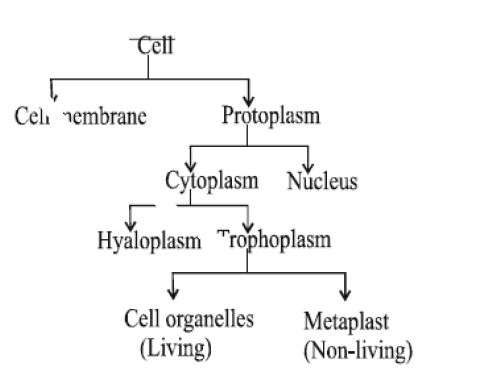
(i) Protoplasm (Essence of life):-
The entire matter found inner to the cell membrane is called as protoplasm. All the living components of a cell lie in the protoplasm and perform their functions.
1. Protoplasm – termed by Purkinje
2. Physical basis of life – Huxley
It can be divided into 2 parts:-
(A) Nucleus (B) Cytoplasm
(A) Nucleus:- Headquarter of the cell. Discovered by – Robert Brown (1831) “Nucleus is double membrane bound dense protoplasmic body, which controls all cellular metabolism and encloses the genetic information of cell”.
Structure:- It is made up of following four contents:
(a) Nuclear membrane / Nuclear envelope / Karyotheca
(b) Nuclear sap / Nucleoplasm / Karyolymph.
(c) Nucleolus.
(d) Chromatin threads.
(a) Nuclear envelope:- Nucleus is surrounded by two membranes, that separates nucleoplasm from cytoplasm. The outer membrane is continuous with endoplasmic reticulum. The nuclear membrane has minute pores. These are called nucleo-pores.
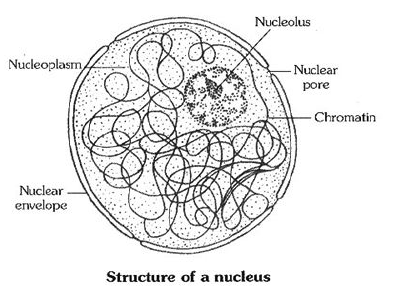
(a) Nucleoplasm:- The part of protopalsm which is enclosed by nuclear membrane. It contains chromatin threads and nucleolus.
(b) Nucleolus:- Discovered by Fontana.Usually one nucleolus is present in each nucleus but sometimes more than one nucleoli are present. It is a store house of RNA & site of r-RNA transcription and processing of ribosome assembly.
(a) Chromatin Threads:- A darkly stained network of long and fine threads called chromatin threads.Chromatin threads are intermingled with one another forming a network called chromatin reticulum.At the time of cell division the chromatin threads separate apart from one another and become smaller and thicker, are called chromosomes.
Functions of Nucleus:-
(i) It controls all the metabolic activities of the cell and regulates the cell cycles.
(ii) It helps in transmission of hereditary characters from parents to offsprings.
(iii) Nucleus plays a central role in the cellular reproduction (division of single cell to form two cells).
(iv) Along with environment, nucleus also directs the chemical activities of the cell. This determines the development and future form of the cell.
(A) Cytoplasm:- The substance present between cell membrane and nucleus is called cytoplasm.It contain jelly like fluid with various structure floating on it known as cell organelles.
Functions:-
(i) It helps in intracellular distribution of molecules, enzymes and nutrients within the cell.
(ii) It helps in exchange of materials between different cell organelles.
(iii) Biosynthesis of nucleotides, proteins and fatty acids takes place in the cytoplasm.
(iv) Breaking down of glucose takes place in the cytoplasm.
Cell organelles / Cytoplasmic organs:- Cell organelles are the living part of cell having definite shape, structure and function. They are playing an important role in cell activities and embedded into cytosol. Cell organelles are often called as “small organs” and also bounded by a plasma membrane like fluid-mosaic membrane.
(i) Mitochondria:- It is a rod shaped structure found in cytoplasm of all eukaryotic cells except mammalian RBC’s. It is absent in prokarytes.It is power house of cell or ATP- mill in cell and cell within cell / second largest organelle of cell. Mitochondria term given by Benda(1897).
Structure:-
- It is double membrane bound cell organelle.
- The outer membrane is smooth and straight. The inner membrane is infolded into the cavity. These fingre-like infoldings are called as cristae.
- Mitochondrial matrix have enzyme for kreb’s cycle. Beside these enzymes matrix have a complete protein synthesis a p p a r a t u s (Ribosome- 70- s, DNA & RNA, enzymes ) so mitochondria called as semi autonomous cell organelle.

Function:-
- Its main function is to produce and store the energy in the form of ATP, that’s why is also known as powerhouse of the cell.
- (i) Mitochondrial matrix- Site of Krebs cycle.
(i) Peri- mitochondrial space- Site of link reaction.
(ii) oxysomes – Site of ETS.
(ii) Plastids:-
Plastid term used by Haeckel, Chloroplast term given by Schimper.
Structure:-
It is double membrane bound cell organnelle and is the largest organelle of cell.
Plastids have following 2 parts:-
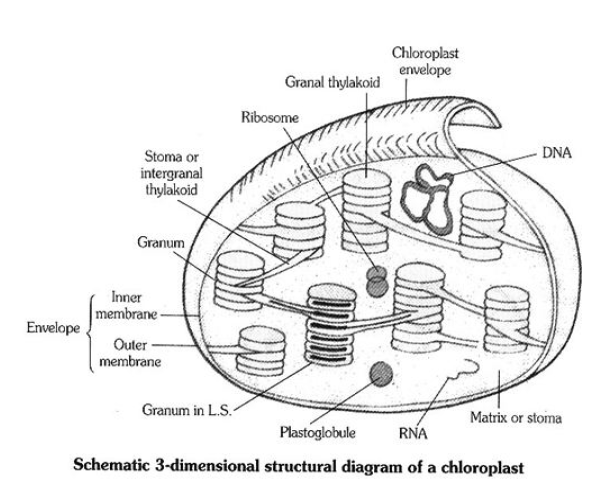
(a) Grana:- It constitues of the lamellar system.
- These are found in layer on top of each other, these stacks are called as grana.
- Each lamella is made up of unit membrane.
- Each granum of chloroplast is formed by superimposed, closed compartments called thylakoid.
- Different grana are connected with the helpof tubular connection, called stroma lamellae or fret channels or intergranum.
Function:- Site of light reaction.
(b) Stroma:- It is a granular transparent substance filled in cavity of chloroplast.
It is also called as matrix. Grana are embedded in it.
- It contains enzymes of calvin cycle or dark reaction. Rubisco is the most abundant enzyme on the earth. It made 16% protein of the chloroplast.
Function:- Site of dark reaction.
Functions:
1. Chloroplasts, the green plastids, help in photosynthesis and thus, help in the synthesis of food.These are called kitchen rooms of the cell.
2. Chromoplasts are coloured plastids which provide colour to the flowers and the fruits.
3.Leucoplasts help in the storage of food.
(ii) GOLGI COMPLEX
Discovered by Camillo Golgi (1898) in nerve cells of owl.
Other names:-
(i) Lipochondrion
(ii) Idiosome,
(iii) Baker’s body.
(iv) Dalton complex
(v) Dictyosomes- In plants
Position:- It is located near the nucleus.
Golgi bodies are pleomorphic structure, because component of Golgi body differ in structure & shape in different cells.Golgi apparatus has a convex forming face and a concave maturing face. The forming face receive vesicles from endoplasmic reticulum. The maturing face produces secretory vesicles and lysosomes.
Structure:- It is formed of four types of contents.
(i) Cisternae (ii) Tubules (iii) Vacuoles (iv) Vesicles Golgibody is single membrane bound cell organelle
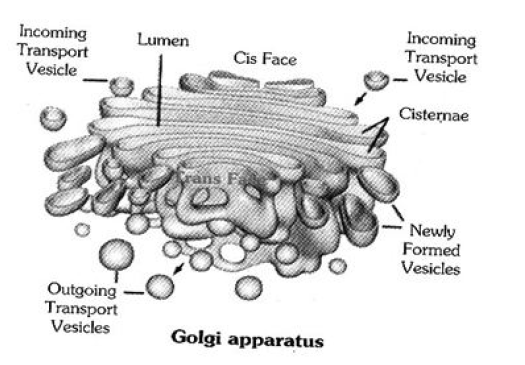
Function:-
- It is involved in cell- secretion and acts as storage, modification and condensation or packaging membrane.
- It foms the acrosome of sperm
- It forms the lysosomes and secretory vesicles.
- It is the site for formation ofglycolipids and glycoproteins.
- Synthesis of cell wall material (Polysaccharide synthesis).
- Cell plate formation (phragmoplast) during cell formation.
- Vitelline membrane of egg is secreted by Golgi body.
(ii) Endoplasmic Reticulum
First observed by Garnier (1897)- Termed as Ergastoplasm.E.R. name proposed by K.R. Porter. (Credit for discovery of ER goes to Porter claude and fullam)
Components of Endoplasmic Reticulum:-
(i) Cisternae:- Flat & unbranched
(ii) Vesicles:- Ovate structure
(iii) Tubules:- net like structure It is also known as “System of Membranes”.
Types of Endoplasmic Reticulum:
(a) Rough E.R. /Granular E.R. Ÿ
Ribosomes present
- Concerned with protein synthesis
(b) Smooth E.R./ Agranular E.R. Ÿ
Ribosomes absent
- Concerned with glycogen and lipid metabolism
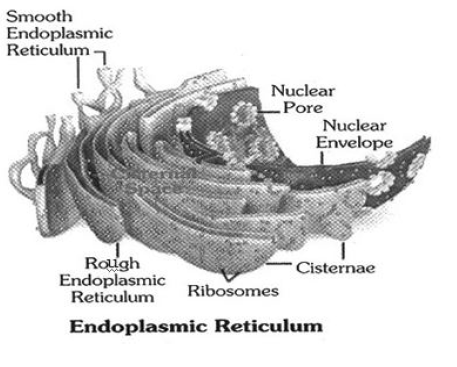
Function:-
- Mechanical support. (make skeleton of cell)
- Rough E.R. – synthesis of protein
- Smooth E.R.- Glycogen and lipid metabolism
- Detoxification
- Circulation
- Formation of lysosomes, Golgi-body & Micro-bodies – All the organellesare formed by E.R. which have membrane except chloroplastand mitochondria. Ÿ E.R. provides the precursor of secretory material to Golgi body.
(v) Lysosome
First observed and the term coined by Christian De Duve (1955). Lysosomes are spherical bag like structures (0.1– 0.8 m) which is covered by single unit membrane. Lysosomes are filled about 50 different types of digestive enzymes termed as acid hydrolases. Lysosomes are highly polymorphic cell organelles. Because, during functioning, lysosomes have different morphological and physiological states. Mostly found in animal cells and in some plant cells e.g. neurospora, cauliflower and bean.
Types of Lysosomes
- Primary lysosomes or storage granules
- Digestive vacuoles or Heterophagosomes
- Residual bodies
- Autophagic lysosomes or cytolysosomes or autophagosomes
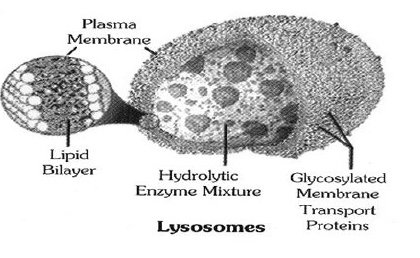
Function:-
- It involves in digestion of foreign materialsreceived in cell by phagocytosis and pinocytosis.
- Digestion of old or dead cell organelles.Autophagy also takes place during starvation of cell.
- Sometimes all lysosomes of a cell burst to dissolve the cell completely.
That’s why lysosomes are also known as suicidal bags
(vi) Ribosome (Engine of cell)
Claude (1941) first observed them and called microsome. Plade (1955) coined the term Ribosome.
- Except mammalian RBC all living cells ha v e Ri b o so me s.( Both prokaryotes& Eukaryotes)
- These are the smallest and membraneless cell organelles.

Function:-
Site of protein synthesis, so these are also called protein factories.
At the time of protein synthesis, several ribosomes become attached to m-RNA with the help of smaller subunits. This structure is called polyribosome or poly some or ergo some.
(vi) Peroxisomes / Uricosomes.
- Discovered by Rhodin & Tolbert.
- Peroxisome term was first used by De Duve.
In plants peroxisomes occur in cells of green tissues and concerned with photorespiration.(Glycolate pathway). It contains per-oxide forming enzymes.
Function:-
(i) ß -oxidation of fatty acids.
(ii) Concerned with photorespiraton.
(iii) In animal cells peroxisomes concerned with peroxide (H2O2) metabolism.
(viii) Vacuoles:-
Vacuoles of animal cells arise from Golgi-complex. It is surrounded by tonoplast. In animals the vacuoles are smaller in size and larger in number while in plants it is larger in size and fewer in number. Vacuoles are storage
sacs for liquid or solid contents.
Function:-
(i) These serve for storage.
(ii) Transport of dissolved, secretory or excretory substances.
(iii) Vacuoles help the plant cells to remain turgid.
(iv) They play an important role in growth by helping in the elongation of cells.
(v) They provide an aqueous environment for the accumulation and storage of water-soluble compounds (sugars, minerals, pigments, etc.).
(vi) In protozoans like Amoeba and Paramecium, vacuoles help in digestion and excretion.
(ix) Centrosome :- Discovered by Benden. Boveri named as centrosome.
Centrosome is generally found in animal cells. Only few types of plant cells show its presence.
It is situated near the nucleus of the cell and shaped like star. Each centrosome has two centrioles.
The two centrioles are placed perpendicular to each other. Centriole consist of 9 triple fibres of tubulin. (9 + 0 arragnement).
Function:-
(i) In animal cells centrioles play important role in initiation of cell division by arranging spindle fibres between two poles of cell.
(ii) The location of centrioles during cell division decides the plane of division.
(iii) It form the basal granule of cilia and flagella in micro-organisms, zoo-spores& motile gametes.
(iv) Form tail of sperm.
Introduction:
- A group of similar cells which perform a particular function is called a tissue.
- Term tissue was coined by Bichat.
- Branch of biology deals with the study of tissue is called Histology.
Tissues can be divided into two types – plant tissues and animal tissues.
Plant Tissues
Mainly they are of two types:
1. Meristematic
2. Permanent
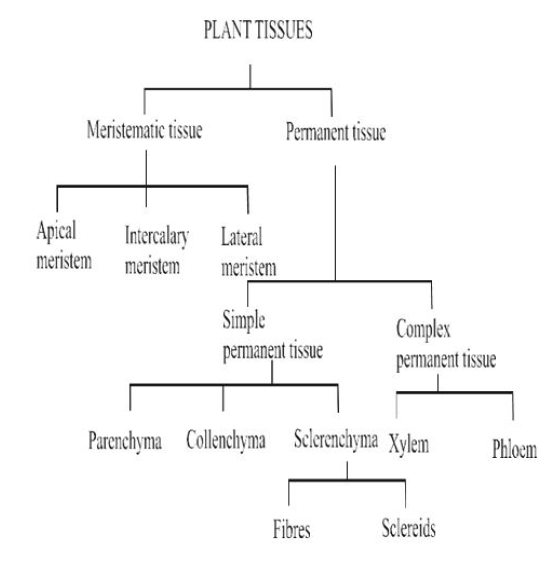
(a) Meristematic Tissue: These are simple living tissues having thin walled compactly arranged immature cells which are capable of division and formation of new cells.
(i) Main features of meristematic tissues are:
- Thin primary cell wall (cellulosic).
- Intercellular spaces are absent (Compact tissue).
- Generally vacuoles are absent, dense cytoplasm & prominent nuclei are present.
- Large number of cell organelles are present.
- Active metabolic state, stored food is absent.
- Actively dividing cells are present in growing regions of plants, e.g. root & shoot tips.
(ii) Classification on the basis of origin:
(A) Primary (Promeristem):
Derived directly from the meristems of embryo.
(B) Secondary:
Formed by primary permanent tissues.
(iii) Classification on the basis of location:
(iii) Classification on the basis of location:
(A) Apical meristem:- It is present at the growing tips of stems and roots. Cell division in this tissue leads to the elongation of stem & root thus it is involved in primary growth of the plant.
(B) Intercalary meristem:- It is the part of apical meristem which is left behind during growth period.
These are present at the base of leaf & internode region. These lead to the increase in the length of leaf (Primary growth) e.g. in grass stem, bamboo stem, mint stem etc.
(C) Lateral meristem:- It is also called as secondary meristem.
(b) Permanent Tissue:
- The permanent tissues are composed of those cells which have lost their capability to divide.
- The division & differentiation of the cells of meristematic tissues give rise to permanent tissues.
- The permanent tissues are classified into
(i) Simple permanent tissues: These tissues are made up of same type of cells which are similar
structurally and functionally. They include two types of tissues:
(A) Protective Tissues: These tissues are primarily protective in function. They consist of :
1. Epidermis: Epidermis forms unicellular thick outermost layer of various body organs of plants such as leaves, flowers, stems and roots. Epidermis is covered outside by cuticle. Cuticle is a water proof layer of waxy substance called as cutin.
Culticle is very thick in xerophytes.
Cells of epidermis of leaves are not continuous at some places due to the presence of small pores called as stomata. Each stomata is guarded by a pair of bean shaped cells called as guard cells.
Function:
- The main function of epidermis is to protect the plant from desiccation and infection.
- Cuticle of epidermis cuts the rate of transpiration and evaporation of water and prevents wilting.
- Stomata in epidermis allow gaseous exchange to occur during photosynthesis and respiration.
- Stomata also helps in transpiration. Cork is made up of dead cells with thick walls and do not have any intercellular spaces. The cell walls in cork deposit waxy substance called as suberin.
(B) Supporting tissue: These are supportive in function and are of three types:
Parenchyma: It is the fundamental tissue, parenchymatous cells have thin cell wall.
- Cell wall mainly composed of cellulose & pectin.
- Large central vacuole for food & water storage.
- Primary function is food storage.
- Chloroplast containing parenchyma tissues are chlorenchyma whichperform photosynthesis. e.g. mesophyll of leaves.
- In hydrophytic plants aerenchyma (A type of parenchyma containingair spaces) provides buoyancy. Collenchyma: It is the living mechanical tissue.
- Elongated cells with thick corners.
- Localized cellulose & pectin thickening.
- Provides flexibility to plant parts & easy bending of various parts ofplant.
- It gives mechanical strength & elasticity to the growing stems.
Sclerenchyma: (Scleras-hard)
- Strengthening tissue.
- Composed of extremely thick walled cells little or no protoplasm.
- Cells are dead & posses very thick lignified walls.
- Lignin is water proof material.
- Inter cellular spaces are absent.
Cells of sclerenchyma are of two types:
1. Sclereids:- Small stone cell or grit cell, having small lumen and thick cell wall.
2. Fibres:- They are very long, narrow, thick, lignified cells.
Sclerenchyma fibres are used in the manufacture of ropes, mats & certain textile fibres. Jute & coir are obtained from the thick bundles of fibres.
(ii) Complex permanent tissue: It consists of more than one type of cells which work together as a unit.
It helps in transportation of organic materials, water & minerals. It is also known as conducting or vascular tissue.
Xylem & phloem together form vascular bundles.
(A) Xylem:- Also known as wood and is a vascular and mechanical tissue. Thick walled cells are found in the form of tubular passages.
Xylem consists of four types of cells called as elements:
Tracheids: They are elongated angular dead cells (primary elements) mainly involved in conduction of water & minerals in gymnosperms.
Vessels: They are advance elements (generally found in angiosperms). Vessels are cylindrical tube like structures placed one above the other end to end which form a continuous channel for efficient conduction of water.
Xylem parenchyma: They are small & thick walled parenchymatous cells subjected for storage of starch (food).
Xylem sclerenchyma: They are non living fibres with thick walls & narrow cavities. Provide mechanical support.
Except xylem parenchyma all other xylem elements are dead.The annual rings present in the trunk of a tree are xylem rings.By counting the number of annual rings we can determine the age of a tree is known as dendrochronology.
(B) Phloem: They also consist of both parenchymatous & sclerenchymatous cells.
Phloem consists of four types of elements:
- Sieve tubes: Sieve tubes are slender tube like structures made up of elongated, thin walled cells placed end to end. Nucleus of sieve cell is absent at maturity.
- Companion cells: Companion cells have dense cytoplasm and prominent nuclei.
- Phloem fibre: They give mechanical support to sieve tubes.
- Phloem parenchyma: They store food & help in radial conduction of food.In phloem except phloem sclerenchyma all elements are living.
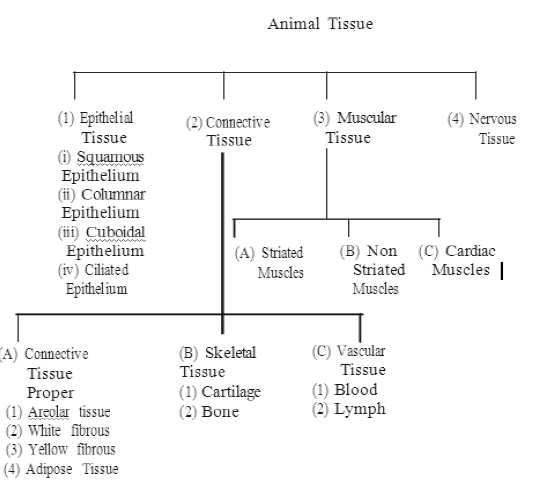
Epithelial Tissue:-
Word epithelium is composed of two words Epi-upon, Thelio-groups. Means- A tissue
which grows upon another tissue is called epithelium.
Nature:-
It is the simplest tissue.
It is the protective tissue of the animal body (as epidermis of plants)
It always rest upon underlying connective tissue. Epithelium cells are closely packed with each other so there is very little inter-cellular space.
Epithelial tissue may be simple (composed of a single layer of cell) or startified (made up of several layers of cells).
White fibrous connective tissue: They have very little matrix containing abundant white fibres forming layers. Bundles of this tissue are called as tendons, which attaches muscles to the bones.
Yellow fibrous connective tissue: They are very elastic due to the presence of a network of yellow fibres in it’s matrix called as ligament which attaches bone to bone.
Muscular tissue: Movements are brought about in our body with the help of muscular tissues.
Types :- It is of three types:
(i) Striated muscles: They are also called as voluntary muscles because these are under the control of one’s will.
(ii) Non- striated muscles:- They are involuntary muscles also called as smooth muscles. These muscles fibres are uninucleated & spindle shaped.
(iii) Cardiac muscle fibres:- They are involuntary muscles. Only found in the walls of heart. Their structure is in between the striated & non-striated muscles. They are uninucleated & branched.
Branches are united by intercalated disc. In these muscles rhythmic contraction & relaxation occurs throughout the life.
Nervous Tissue:-
They are highly specialized tissue due to which the animals are able to perceive and respond to the stimuli.
Their functional unit is called as nerve cell or Neuron. Cell body is cyton covered by plasma membrane.
Short, hair like extensions arising from cyton are dendron which are further subdivided into dendrites.
Axon is long, tail like cylindrical process with fine branches at the end. Axon is covered by a sheath.
Function:
(i) They control all the body activities
They co-ordinate between various body parts during any body function. Spinal cord & brain are made up of nervous tissue.
Question: A tissue is
a) a group of separate organs that coordinates in their activities
b) a group of cells which are similar in function and structure
c) layer of cells that surrounding an organ
d) sheet of cells that is one layer thick
Answer: b
Question: The wall of cork cells are heavily thickened by the deposition of
a) cutin
b) suberin
c) lignin
d) pectin
Answer: b
Question: Which muscle cell is spindle shaped?
a) Smooth muscle cell
b) Striated muscle cell
c) Cardiac muscle cell
d) None of these are correct
Answer: a
Question: Blood is formed of –
a) Plasma and bone marrow cells
b) Plasma, white & red blood cells and blood platelets.
c) Plasma & WBC
d) Plasma & RBC
Answer: b
Question: Myelin sheath is a layer covering-
a) vertebrate nerve fibre
b) vertebrate muscle fibre
c) insect nerve fibre
d) chick embryo
Answer: a
Question: Adipose tissues store-
a) protein
b) carbohydrate
c) fat droplets
d) All of the above
Answer: c
Question: A protective noncellular layer found on the outside of plant organ is-
a) Epiblema
b) Velamen
c) Cuticle
d) Cork
Answer: c
Question: Contraction and relaxation are unique features of
a) Epithelial tissue
b) Connective tissue
c) Muscle tissue
d) Nervous tissue
Answer: c
Question: Specialised parenchyma occurring in aquatic plants is –
a) Prosenchyma
b) Chlorenchyma
c) Aerenchyma
d) None
Answer: c
Question: Root hairs are –
a) unicellular
b) multicellular
c) acellular
d) mixed type
Answer: a
Question: Sieve tubes are found in –
a) xylem
b) phloem
c) cortex
d) pith
Answer: b
Question: Apical meristem, intercalary meristem and lateral meristem are differentiated on the basis of –
a) development
b) position
c) function
d) origin
Answer: b
Question: Phloem in the plants does the function of –
a) photosynthesis
b) providing support
c) conduction of food
d) conduction of water
Answer: c
Question: Which of the following tissue is composed of mainly dead cells?
a) Phloem
b) Epidermis
c) Xylem
d) Endodermis
Answer: c
Question: Active divisions take place in the cells of :
a) Xylem
b) Phloem
c) Sclerenchyma
d) Cambium
Answer: d
Question: Double membrane is absent in –
a) Mitochondrion
b) Chloroplast
c) Nucleus
d) Lysosome
Answer: d
Question: Animal cell is limited by-
a) Plasma membrane
b) Shell membrane
c) Cell wall
d) Basement membrane
Answer: a
Question: The network of endoplasmic reticulum is present in the –
a) Nucleus
b) Nucleolus
c) Cytoplasm
d) Chromosomes
Answer: c
Question: The radiant energy of sunlight is converted to chemical energy and stored as –
a) AMP
b) ADP
c) ATP
d) APP
Answer: c
Question: An animal cell differs from a plant cell in respect of –
a) ER
b) Cell wall
c) Ribosomes
d) Cell membrane
Answer: b
Question: The longest cell in human body is –
a) Neuron
b) Muscle fibre
c) Epithelial cell
d) Bone cell
Answer: a
Question: Which organelle releases oxygen?
a) Ribosome
b) Golgi appartus
c) Mitochondria
d) Chloroplast
Answer: d
Question: The wall of cork cells are heavily thickned by the deposition of
a) cutin
b) suberin
c) lignin
d) pectin
Answer: b
Question: Which of the following is called the brain of the cell?
a) Nucleus
b) Mitochondria
c) Ribosomes
d) Plasma membrane
Answer: a
Question: Ball and socket joint is found in –
a) knee
b) shoulder
c) foot
d) elbow
Answer: b
Question: Which of the following help in synthesis of ribosomes?
a) m-RNA
b) r-RNA
c) t-RNA
d) DNA
Answer: b
Question: Human bones are made up of –
a) Calcium
b) Phosphorous
c) Calcium & Phosphorous
d) Calcium & Magnesium
Answer: c
Question: Adipose tissues store-
a) protein
b) carbohydrate
c) fat droplets
d) All of the above
Answer: c
Question: The radiant energy of sunlight is converet to chemical energy and stored as –
a) AMP
b) ADP
c) ATP
d) APP
Answer: c
Question: Which of the following is an inclusion ?
a) Mitochondrion
b) Lysosome
c) Golgi complex
d) Starch grain
Answer: d
Question: Tendons join –
a) muscles to muscles
b) bones to muscles
c) bones to bones
d) none of the options
Answer: b
Question: Contraction and relaxation are unique features of
a) Epithelial tissue
b) Connective tissue
c) Muscle tissue
d) Nervous tissue
Answer: c
Question: The membrane surrounding the vacuole of a plant cell is called
a) Tonoplast
b) Plasma membrane
c) Nuclear membrane
d) Cell wall
Answer: a
Question: Which of the following phenomena is commonly referred as ‘cell drinking’?
a) Exocytosis
b) Pinocytosis
c) Endocytosis
d) Phagocytosis
Answer: b
Question: Phloem in the plants does the function of –
a) photosynthesis
b) providing support
c) conduction of food
d) conduction of water
Answer: c
Question: Double membrane is absent in –
a) Mitochondrion
b) Chloroplast
c) Nucleus
d) Lysosome
Answer: d
Question: Jaffrabadi is a breed of :
a) Sheep
b) Cattle
c) Horse
d) Buffalo
Answer: d
Question: The cell organelle associated with cell secretion is
a) Plastids
b) Mitochondria
c) Golgi apparatus
d) Nucleolus
Answer: c
Question: Name of freshwater edible fish
a) Hilsa
b) Pomphret
c) Calbasu
d) Bombay duck
Answer: c
Question: Apical meristem, intercalary meristem and lateral meristem are differentiated on the basis of –
a) development
b) position
c) function
d) origin
Answer: b
Question: The cellular structure concerned with intra cellular digestion is
a) mitochondria
b) chloroplast
c) ribosome
d) lysosome
Answer: d
Question: The sedimentation coefficient of complete ribosome in bacterial cell is
a) 70S
b) 80S
c) 78S
d) 60S
Answer: a
Question: Power house of the cell is
a) Mitochondria
b) Ribosome
c) Lysosome
d) Golgi body
Answer: a
Question: Which cell organelle is absent in human sperm?
a) ER
b) Nucleus
c) Centrioles
d) Mitochondria
Answer: a
Question: Which of the following is a nonliving cell inclusion?
a) Vacuoles
b) Ribosomes
c) Centrosomes
d) Golgi complex
Answer: a
Question: ‘Physical basis of life’ is the term used for
a) Cytoplasm
b) Protoplasm
c) Nucleoplasm
d) Sarcoplasm
Answer: b
Question: The red colour of the tomato is due to
a) leucoplast
b) chromoplast
c) chloroplast
d) none of these
Answer: b
Question: Which one of the following is common in plant and animal?
a) Mitochondria
b) Chloroplast
c) Centriole
d) Cell wall
Answer: a
Question: Which of the following is called ‘an organelle within an organelle’?
a) Plastid
b) Ribosome
c) Lysosome
d) Microsome
Answer: b
Match the items of :
Column A Column B
(A) Platelets (1) attached bon with muscle
(B) Neuron (2) locomotion
(C) Tendon (3) blood coagulation
(D) Striated muscle (4) respond tostimuli Which of the following is correct?
(A) (a-2), (b-3), (c-4), (d-1)
(B) (a-3), (b-4), (c-1), (d-2)
(C) (a-4), (b-1), (c-2), (d-3)
(D) (a-1), (b-2), (c-3), (d-4)
Answer: b
CBSE Class 7 Science Cell Notes
We hope you liked the above notes for topic Cell which has been designed as per the latest syllabus for Class 7 Science released by CBSE. Students of Class 7 should download and practice the above notes for Class 7 Science regularly. All revision notes have been designed for Science by referring to the most important topics which the students should learn to get better marks in examinations. Our team of expert teachers have referred to the NCERT book for Class 7 Science to design the Science Class 7 notes. After reading the notes which have been developed as per the latest books also refer to the NCERT solutions for Class 7 Science provided by our teachers. We have also provided a lot of MCQ questions for Class 7 Science in the notes so that you can learn the concepts and also solve questions relating to the topics. We have also provided a lot of Worksheets for Class 7 Science which you can use to further make yourself stronger in Science.
You can download notes for Class 7 Science Cell for latest academic session from StudiesToday.com
Yes, the notes issued for Class 7 Science Cell have been made available here for latest CBSE session
There is no charge for the notes for CBSE Class 7 Science Cell, you can download everything free of charge
www.studiestoday.com is the best website from which you can download latest notes for Cell Science Class 7
Come to StudiesToday.com to get best quality topic wise notes for Class 7 Science Cell

